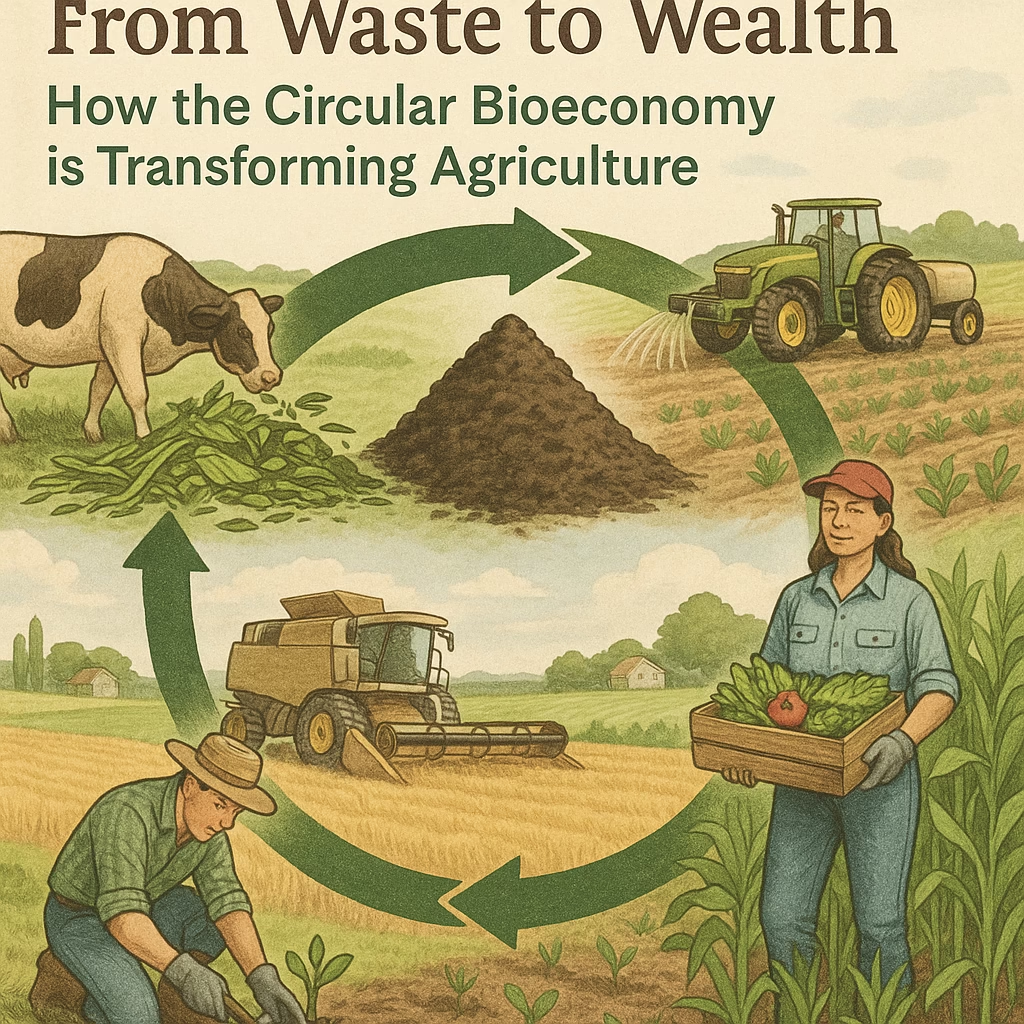Imagine a farm where nothing truly goes to waste. Where every byproduct, every leftover from field or animal, is seen not as a problem but as a valuable resource. This isn’t a futuristic fantasy; it’s the practical, innovative heart of the circular bioeconomy (CBE) in agriculture. For generations, much of agriculture has operated on a linear “take-make-dispose” model: resources are taken, products are made, and wastes are often discarded, sometimes leading to environmental challenges and economic losses (Geissdoerfer et al., 2017). But a paradigm shift is underway. The circular bioeconomy offers a transformative pathway to make agriculture more sustainable, economically viable, and resilient to future challenges. This article explores what CBE truly means for the agricultural sector, the exciting strategies turning “waste” into wealth, and the profound benefits it promises for farmers, our environment, and global food systems.

What Exactly is a Circular Bioeconomy in Agriculture?
At its core, a circular bioeconomy in agriculture mimics nature’s own highly efficient, cyclical systems. It’s about intelligently using renewable biological resources – crops, animals, microorganisms, and their associated organic streams – to produce food, feed, bio-based products, and bioenergy, while drastically minimizing waste and environmental impact (European Commission, 2018). Key principles include:
- Designing out waste and pollution: Shifting focus from end-of-pipe waste management to preventing waste generation in the first place.
- Keeping products and materials in use: Extending the lifespan and utility of biological resources through cascading use, reuse, and recycling.
- Regenerating natural systems: Adopting practices that not only conserve but also enhance soil health, biodiversity, and water quality.
- Decoupling economic activity from the consumption of finite resources: Creating value without proportionally increasing resource depletion.
In essence, it’s a transition from a linear system (inputs → farm production → products + substantial waste) to a more holistic, circular one where byproducts and “wastes” become valuable inputs for other processes, either on the farm itself or in interconnected bio-based industries (MacArthur Foundation, 2013).
Key Strategies: Turning Agricultural “Waste” into Valuable Resources
The implementation of a circular bioeconomy in agriculture relies on a diverse toolkit of innovative strategies and technologies:
1. Smart Valorization of Crop Residues:
- Post-harvest, substantial amounts of lignocellulosic biomass (straw, stalks, leaves, cobs) remain. Instead of traditional disposal methods like burning (which causes air pollution) or simple incorporation (which can be slow), CBE strategies include:
- Bioenergy Production: Converting residues into biogas for heat and electricity through anaerobic digestion, or into biofuels (e.g., cellulosic ethanol, bio-oil) and biochar via thermochemical processes like gasification and pyrolysis (Demirbas, 2009). The digestate from anaerobic digestion and biochar from pyrolysis are excellent soil amendments.
- Enhanced Animal Feed & Bedding: Employing treatments like ammoniation or ensiling to improve the digestibility and nutritional value of crop residues for livestock, or using them as sustainable animal bedding.
- Development of Biocomposites and Biomaterials: Utilizing plant fibers to create biodegradable plastics, sustainable packaging solutions, building materials, and even textiles, reducing reliance on fossil fuel-based synthetics (Mohanty, Misra, & Drzal, 2002).
- Extraction of Platform Biochemicals: Breaking down residues into constituent sugars, lignin, and other molecules that serve as building blocks for a wide array of bio-based chemicals and materials in biorefineries.
2. Maximizing the Potential of Animal Manures and Slurries:
- Animal manure, if mismanaged, can be a significant source of greenhouse gas emissions and water pollution. In a CBE, it becomes a prime resource:
- Nutrient-Rich Biofertilizers: Advanced composting, vermicomposting, and the processing of digestate from anaerobic digestion transform manure into stable, nutrient-rich organic fertilizers that enhance soil health, reduce the need for synthetic fertilizers, and minimize nutrient losses (Chadwick, Sommer, Harrison, et al., 2011).
- On-Farm Energy Generation: Anaerobic digestion of manure produces biogas (methane), which can be used for heating, electricity generation, or even as vehicle fuel, while significantly mitigating methane emissions from manure storage (Holm-Nielsen, Al Seadi, & Oleskowicz-Popiel, 2009).
- Innovative Nutrient Recovery Technologies: Systems like struvite precipitation can recover phosphorus and nitrogen from liquid manure fractions, creating concentrated, marketable fertilizer products.
3. Upcycling Agri-Food Processing Byproducts:
- The transformation of raw agricultural products into consumer goods (e.g., fruit juicing, vegetable canning, dairy processing) generates significant quantities of byproducts (pomace, peels, whey). CBE focuses on:
- Extraction of High-Value Bioactive Compounds: Many byproducts are rich sources of antioxidants, pigments, dietary fibers, enzymes, and proteins, which can be extracted for use in functional foods, nutraceuticals, cosmetics, and pharmaceuticals (GalanaKIS, 2012).
- Formulation of Animal Feed: A well-established practice, but with ongoing research to optimize nutritional value and incorporation rates of diverse byproducts into animal diets.
- Substrates for Industrial Fermentation: Byproducts can serve as cost-effective nutrient sources for microbial fermentation to produce organic acids, alcohols, enzymes, or single-cell protein.
4. Closing Nutrient Loops at Farm and Regional Scales:
- Efficiently cycling essential plant nutrients (nitrogen, phosphorus, potassium) is paramount:
- Integrated Crop-Livestock Systems: These systems inherently promote nutrient cycling, with manure fertilizing croplands and crop residues often used as animal feed, reducing external input needs (Russelle, Entz, & Franzluebbers, 2007).
- Safe Reuse of Treated Wastewater and Biosolids: In water-scarce regions, treated wastewater can be a valuable resource for irrigation. Similarly, carefully treated sewage sludge (biosolids) can recycle nutrients back to agricultural land, subject to strict safety standards to manage contaminants and pathogens (WHO, 2006).
5. Sustainable Resource Management as the Bedrock:
- CBE is not just about end-of-pipe solutions; it begins with optimizing resource use from the outset:
- Precision Agriculture: Utilizing technologies like GPS, sensors, and data analytics to apply water, fertilizers, and pesticides only where and when needed, minimizing inputs and potential waste (Gebbers & Adamchuk, 2010).
- Diversification of Farming Systems: Practices such as cover cropping, intercropping, and agroforestry enhance soil health, improve internal nutrient cycling, increase biodiversity, and reduce reliance on external inputs (Altieri, 1999).
The Big Wins: Why a Circular Bioeconomy Matters
Adopting circular strategies in agriculture unlocks a cascade of benefits:
- Environmental Gains:
- Reduced Greenhouse Gas Emissions: Mitigating methane from manure and rice paddies, nitrous oxide from excessive fertilizer use, and CO2 from reduced fossil fuel dependency (Smith et al., 2007).
- Improved Soil Health: Increasing soil organic matter, enhancing water retention, promoting beneficial microbial activity, and sequestering carbon.
- Protection of Water Resources: Minimizing nutrient leaching and runoff, thereby reducing eutrophication of water bodies.
- Waste Reduction & Pollution Prevention: Transforming potential pollutants into valuable assets.
- Economic Advantages for Farmers and Rural Economies:
- New Revenue Streams: Income from selling bioenergy, biofertilizers, bioplastics, or other bio-based products.
- Reduced Operational Costs: Lower expenditure on synthetic fertilizers, pesticides, and fossil fuels.
- Enhanced Farm Resilience: Greater independence from volatile prices of external inputs.
- Creation of Green Jobs: Opportunities in biomass collection, processing, logistics, and marketing of bio-products in rural areas.
- Societal and Community Benefits:
- Enhanced Food and Nutrition Security: More efficient resource utilization supports stable and sustainable food production.
- Rural Development & Livelihood Diversification: Strengthening local economies and providing new opportunities.
- Contribution to Sustainable Development Goals (SDGs): Directly addressing goals related to poverty, hunger, clean water, climate action, and responsible consumption and production.
Challenges on the Road to Full Circularity
Despite the compelling vision, the transition to a widespread agricultural CBE faces several hurdles:
- Technological and Infrastructural Gaps: The scalability, efficiency, and cost-effectiveness of some valorization technologies need further development. Lack of decentralized processing facilities and efficient biomass collection/logistics systems can be a bottleneck (Cherubini, 2010).
- Economic and Market Barriers: High upfront investment costs for new technologies and infrastructure can deter adoption. Bio-based products may struggle to compete economically with established, often subsidized, conventional products. Developing stable markets and value chains for novel bio-products is crucial.
- Policy and Regulatory Complexities: Fragmented or unsupportive policy frameworks can hinder progress. Clear, streamlined, and science-based regulations are needed for waste-derived products (e.g., biofertilizers, animal feed components) to ensure safety and build trust.
- Social and Behavioral Factors: Limited awareness, knowledge, and technical expertise among farmers and other stakeholders can slow adoption. Traditional practices and perceived risks associated with new technologies also play a role.
Paving the Way: Accelerating the Circular Transition
Overcoming these challenges requires a concerted, multi-stakeholder effort:
- Supportive and Coherent Governance: Integrating CBE principles into national and regional agricultural, environmental, energy, and industrial policies, with clear targets and roadmaps (Scarlat, Dallemand, Monforti-Ferrario, & Nita, 2015).
- Investment in Research, Development, and Innovation (RD&I): Prioritizing funding for developing and demonstrating cost-effective and scalable CBE technologies and systems.
- Targeted Financial Incentives: Providing grants, subsidies, green loans, or tax breaks to help farmers and bio-based enterprises invest in circular practices and infrastructure.
- Education, Training, and Extension Services: Equipping farmers, advisors, and entrepreneurs with the necessary knowledge and skills to implement CBE solutions.
- Fostering Collaboration and Value Chain Development: Encouraging partnerships between farmers, research institutions, industry players, and government to create robust regional bioeconomy clusters and value chains.
- Market Development and Consumer Awareness: Implementing policies that support market uptake of bio-based products (e.g., public procurement) and raising consumer awareness about their benefits.
The Future is Circular: A Smarter, More Sustainable Way to Farm
The circular bioeconomy is far more than a niche concept; it represents a fundamental rethinking of how we produce food, feed, fiber, and energy. By embracing innovation and viewing “waste” not as an endpoint but as a valuable starting point for new products and processes, agriculture can significantly reduce its environmental footprint, enhance its economic viability, and strengthen its resilience. The journey towards a fully circular agricultural system is ongoing, demanding continued innovation, strategic investment, supportive policies, and a collective commitment to a more sustainable and prosperous future.
References
- Altieri, M. A. (1999). The ecological role of biodiversity in agroecosystems. Agriculture, Ecosystems & Environment, 74(1-3), 19-31.
- Chadwick, D., Sommer, S., Harrison, R., et al. (2011). Optimising manure management for GHG mitigation. Animal Feed Science and Technology, 166-167, 514-531.
- https://www.researchgate.net/publication/287964588_Biorefinery_Concept_An_Overview_of_Producing_Energy_Fuels_and_Materials_from_Biomass_Feedstocks
- Demirbas, A. (2009). Political, economic and environmental impacts of biofuels: A review. Applied Energy, 86, S108-S117.
- Ellen MacArthur Foundation. (2013). Towards the Circular Economy Vol. 1: Economic and business rationale for an accelerated transition. Cowes, UK: Ellen MacArthur Foundation.
- European Commission. (2018). A sustainable Bioeconomy for Europe: Strengthening the connection between economy, society and the environment. Updated Bioeconomy Strategy. Brussels.
- Galanakis, C. M. (2012). Recovery of high added-value components from food wastes: Conventional, emerging technologies and commercialized applications. Trends in Food Science & Technology, 26(2), 68-87.
If you want to learn more about Circular Bioeconomy in Agriculture, check out Agri AI : Smart Farming Advisor and feel free to ask any questions!

Leave a Reply